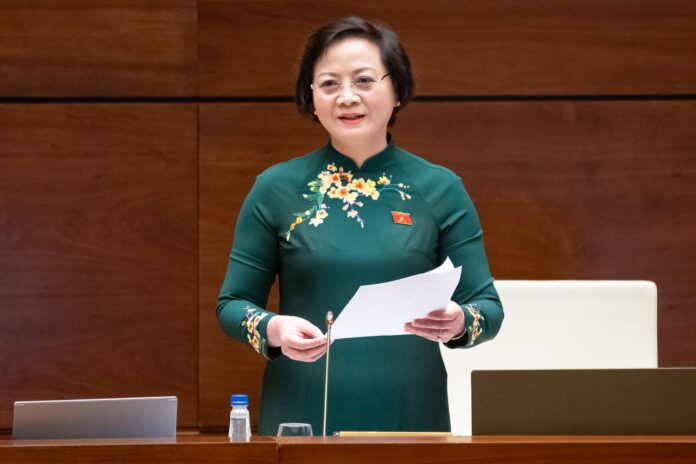On June 12th, with an overwhelming majority of 461 out of 465 delegates voting in favor, the 15th National Assembly of Vietnam passed a resolution on the rearrangement of provincial-level administrative units for the year 2025. The resolution takes effect immediately.

Minister of Home Affairs Pham Thi Thanh Tra provides explanations and clarifications before the National Assembly’s vote. Photo: Pham Thang
The resolution entails the merger of 52 provincial-level units into 23 new provinces and cities as follows:
1. The provinces of Ha Giang and Tuyen Quang will be merged to form the new province of Tuyen Quang, with its political and administrative center located in the current province of Tuyen Quang.
2. Yen Bai and Lao Cai provinces will be merged to create the new province of Lao Cai, with its political and administrative center in the current province of Yen Bai.
3. Bac Kan and Thai Nguyen provinces will be merged to establish the new province of Thai Nguyen, with its political and administrative center in the current province of Thai Nguyen.
4. Vinh Phuc, Hoa Binh, and Phu Tho provinces will be merged to form the new province of Phu Tho, with its political and administrative center in the current province of Phu Tho.
5. Bac Giang and Bac Ninh provinces will be merged to establish the new province of Bac Ninh, with its political and administrative center in the current province of Bac Giang.
6. Thai Binh and Hung Yen provinces will be merged to create the new province of Hung Yen, with its political and administrative center located in the current province of Hung Yen.
7. Hai Duong province and Hai Phong city will be merged to form the new city of Hai Phong, with its political and administrative center in the current city of Hai Phong.
8. Ha Nam, Ninh Binh, and Nam Dinh provinces will be merged to establish the new province of Ninh Binh, with its political and administrative center in the current province of Ninh Binh.
9. Quang Binh and Quang Tri provinces will be merged to form the new province of Quang Tri, with its political and administrative center in the current province of Quang Binh.
10. Quang Nam province and Da Nang city will be merged to create the new city of Da Nang, with its political and administrative center in the current city of Da Nang.
11. Kon Tum and Quang Ngai provinces will be merged to form the new province of Quang Ngai, with its political and administrative center in the current province of Quang Ngai.
12. Gia Lai and Binh Dinh provinces will be merged to establish the new province of Gia Lai, with its political and administrative center in the current province of Binh Dinh.
13. Ninh Thuan and Khanh Hoa provinces will be merged to form the new province of Khanh Hoa, with its political and administrative center in the current province of Khanh Hoa.
14. Lam Dong, Dak Nong, and Binh Thuan provinces will be merged to create the new province of Lam Dong, with its political and administrative center in the current province of Lam Dong.
15. Dak Lak and Phu Yen provinces will be merged to form the new province of Dak Lak, with its political and administrative center in the current province of Dak Lak.
16. Ba Ria-Vung Tau, Binh Duong provinces, and Ho Chi Minh City will be merged to establish the new city of Ho Chi Minh, with its political and administrative center in the current city of Ho Chi Minh.
17. Dong Nai and Binh Phuoc provinces will be merged to form the new province of Dong Nai, with its political and administrative center in the current province of Dong Nai.
18. Tay Ninh and Long An provinces will be merged to create the new province of Tay Ninh, with its political and administrative center located in the current province of Long An.
19. Can Tho city, Soc Trang, and Hau Giang provinces will be merged to form the new city of Can Tho, with its political and administrative center in the current city of Can Tho.
20. Ben Tre, Vinh Long, and Tra Vinh provinces will be merged to establish the new province of Vinh Long, with its political and administrative center in the current province of Vinh Long.
21. Tien Giang and Dong Thap provinces will be merged to form the new province of Dong Thap, with its political and administrative center in the current province of Tien Giang.
22. Bac Lieu and Ca Mau provinces will be merged to create the new province of Ca Mau, with its political and administrative center in the current province of Ca Mau.
23. An Giang and Kien Giang provinces will be merged to form the new province of An Giang, with its political and administrative center in the current province of Kien Giang.
As a result of this resolution, Vietnam will now comprise 34 provincial-level administrative units, including 6 municipalities directly under the Central Government: Hanoi, Ho Chi Minh City, Hai Phong, Hue, Da Nang, and Can Tho; and 28 provinces: Lai Chau, Dien Bien, Son La, Lang Son, Cao Bang, Tuyen Quang, Lao Cai, Thai Nguyen, Phu Tho, Bac Ninh, Hung Yen, Ninh Binh, Quang Ninh, Thanh Hoa, Nghe An, Ha Tinh, Quang Tri, Quang Ngai, Gia Lai, Khanh Hoa, Lam Dong, Dak Lak, Dong Nai, Tay Ninh, Vinh Long, Dong Thap, An Giang, and Ca Mau.
11 provinces and cities that will not undergo any changes include: Cao Bang, Dien Bien, Ha Tinh, Lai Chau, Lang Son, Nghe An, Quang Ninh, Thanh Hoa, Son La, Hanoi, and Hue.


















